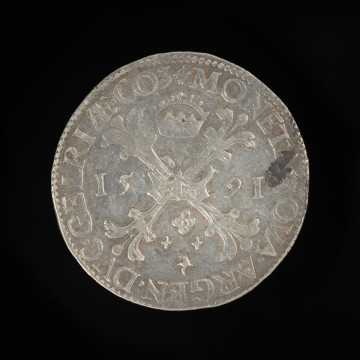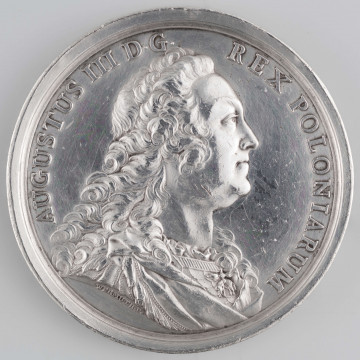
Thaler
1620
National Museum in Szczecin
Part of the collection: European and non-European coins
Ferdinand I Habsburg (1503–1564) strengthened his dynasty’s position in Europe, securing its succession in Germany, Bohemia and Hungary. Before his death, he divided the Habsburg hereditary lands among his sons. Ferdinand II, Archduke of Further Austria, received Tirol, as well as estates in Swabia and southern Alsace. Ferdinand II Habsburg (1529–1595) was prepared for the role of ruler. In 1547, his father made him administrator of Bohemia, where he stayed until 1567. The Archduke was a lover of science and art. He bought valuable books, collected paintings and militaria. He was a capable administrator, but despite the administrative and fiscal reforms in Tirol, his passion for collecting constantly drove him into debt. The sovereign carried out minting production on the basis of the silver deposits in Schwarz, but the presented thaler was not minted in Tirol. It was struck at the opposite end of Ferdinand’s territory – at Ensisheim in southern Alsace. This is indicated by the inscription and coats of arms on the reverse of the coin. In the centre of the reverse is the Spanish coat of arms shield, which is covered by the ducal crown. The shield is encircled by the chain of the Order of the Golden Fleece, the dynastic decoration of the House of Habsburg. The shield bears the coats of arms of the Kingdom of Bohemia, the Kingdom of Hungary, the Breisgau district of Swabia and the Kingdom of Castile and León. In the centre of the shield is a small coat of arms of Alsace. The obverse inscription, being a continuation of the one on the obverse, proclaimed that Ferdinand II, in addition to the title of Archduke of Further Austria, also held the titles of Duke of Burgundy, Landgraf of Alsace and Count of Ferrette. Therefore, small shields were placed on either side of the main coat of arms with the coats of arms of the Lords at Ferrete (lion) and the County of Ferrete (fish). The coin is not dated, but it is believed to have been struck in 1564, at the time of Ferdinand’s allocation of lands in Further Austria. Ferdinand II did not have any sons entitled to inherit the duchy and take it over, so after his death the lands were taken over by his nephew, Emperor Rudolf II Habsburg (1522–1612).
Mieszko Pawłowski
Other names
Taler
Author / creator
Dimensions
cały obiekt:
Object type
coin
Technique
minting
Material
silver
Creation time / dating
Creation / finding place
Owner
National Museum in Szczecin
Identification number
Location / status

1620
National Museum in Szczecin

1591
National Museum in Szczecin

1762
National Museum in Lublin
DISCOVER this TOPIC
National Museum in Lublin
DISCOVER this PATH
Educational path